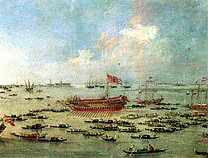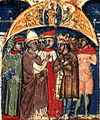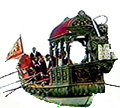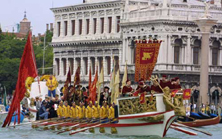|

Legend, myth and history
 In previous centuries this holiday held an important role in the social
and political life of Venice, which resulted in one of the most important
and sumptuous celebrations, interweaving the legend, myth and history
of the city.
In previous centuries this holiday held an important role in the social
and political life of Venice, which resulted in one of the most important
and sumptuous celebrations, interweaving the legend, myth and history
of the city. |
 |

If, historically speaking, the Sensa is the result of an overlapping
of civil and religious rites and events through the ages, today we
prefer to give it the meaning of festivity of the Sea and therefore
of a festivity of a city which draws its raison d'être from
its relationship with the sea.
|
 |
|
Origins
The roots of the Sensa Feast-day lie in the history of Venice, and
more specifically in the episode when Doge Ziani acted as mediator
between Pope Alexander III and Emperor Frederick Barbarossa. |
Marriage to the sea
The Doge of the Serenissima used this rite to demonstrate the Republic’s
dominion in the gulf. The doge and his entourage embarked on the Bucintoro.
On reaching the mouth of San Nicolò port, the Doge threw a
gold ring into the sea. |
|
 |
 |
|
The Sensa Fair
The famous Sensa fair attracted visitors from all over Europe. It
took place in Saint Mark’s Square and lasted 15 days. It gave
merchants an opportunity to display rare merchandise, new fashions,
art and produce from all over the world. |
The Sensa today
Today the ceremony is not as magnificent as in previous centuries,
but the symbolism of the mystic marriage to the sea is still evident
and is certainly still valid today. The Mayor of Venice, civic dignitaries
and religious and military representatives leave Saint Mark’s
Square and sail to the Port of S. Nicolò where the ritual
ring throwing takes place.
|
|
 |
 |
|
Cuisine
In spring, when the Sensa is celebrated, vegetables are in their prime,
especially the ones produced in the wonderful market-gardens of the
islands of the lagoon. Among the most typical recipes, risi e
bisi and the castraure (baby artichokes). |
|

 In previous centuries this holiday held an important role in the social
and political life of Venice, which resulted in one of the most important
and sumptuous celebrations, interweaving the legend, myth and history
of the city.
In previous centuries this holiday held an important role in the social
and political life of Venice, which resulted in one of the most important
and sumptuous celebrations, interweaving the legend, myth and history
of the city.





